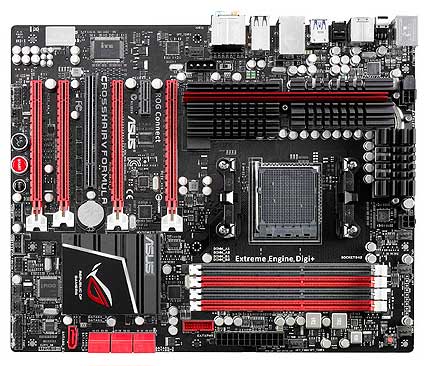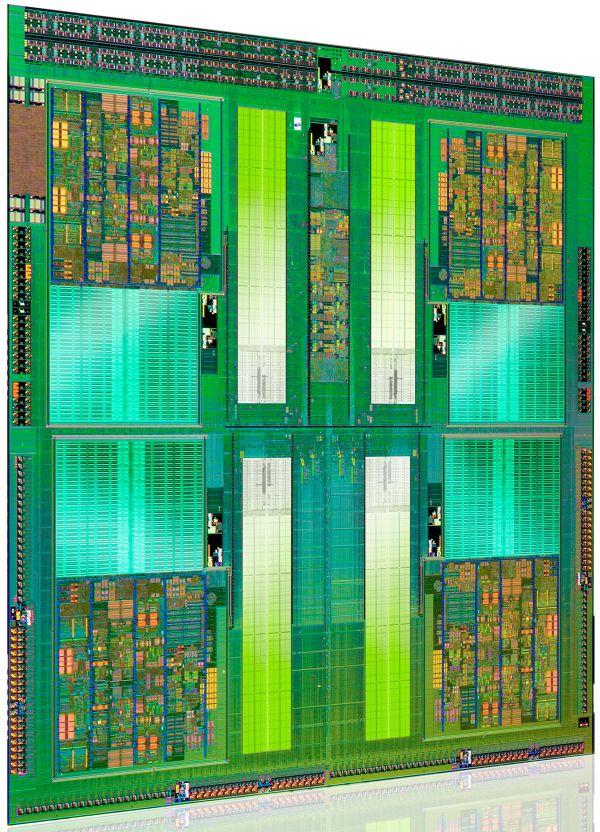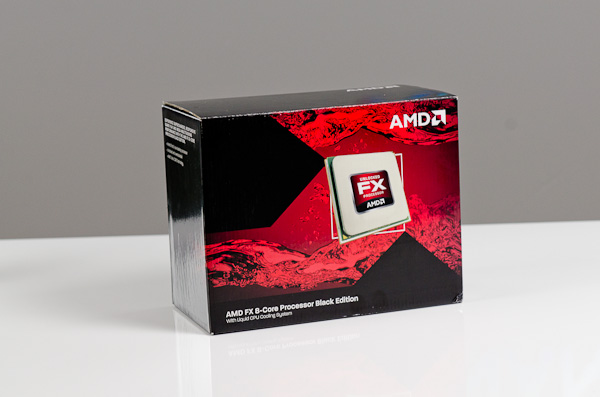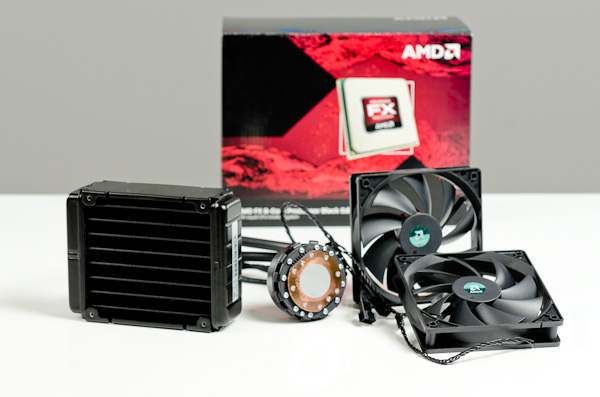The Bulldozer Review: AMD FX-8150 Tested
by Anand Lal Shimpi on October 12, 2011 1:27 AM ESTAMD has been trailing Intel in the x86 performance space for years now. Ever since the introduction of the first Core 2 processors in 2006, AMD hasn't been able to recover and return to the heyday of the Athlon 64 and Athlon 64 X2. Instead the company has remained relevant by driving costs down and competing largely in the sub-$200 microprocessor space. AMD's ability to hold on was largely due to its more-cores-for-less strategy. Thanks to aggressive pricing on its triple and hexa-core parts, for users who needed tons of cores, AMD has been delivering a lot of value over the past couple of years.
Recently however Intel has been able to drive its per-core performance up with Sandy Bridge, where it's becoming increasingly difficult to recommend AMD alternatives with higher core counts. The heavily threaded desktop niche is tough to sell to, particularly when you force users to take a significant hit on single threaded performance in order to achieve value there. For a while now AMD has needed a brand new architecture, something that could lead to dominance in heavily threaded workloads while addressing its deficiencies in lightly threaded consumer workloads. After much waiting, we get that new architecture today. Bulldozer is here.
It's branded the AMD FX processor and it's only available in a single die configuration. Measuring 315mm2 and weighing in at around 2 billion transistors (that's nearly GPU-sized fellas), Bulldozer isn't that much smaller than existing 45nm 6-core Phenom II designs despite being built on Global Foundries' 32nm SOI process. Both die area and transistor count are up significantly over Sandy Bridge, which on Intel's 32nm HKMG process is only 995M transistors with a die size of 216mm2. This is one big chip.
| CPU Specification Comparison | ||||||||
| CPU | Manufacturing Process | Cores | Transistor Count | Die Size | ||||
| AMD Bulldozer 8C | 32nm | 8 | 1.2B* | 315mm2 | ||||
| AMD Thuban 6C | 45nm | 6 | 904M | 346mm2 | ||||
| AMD Deneb 4C | 45nm | 4 | 758M | 258mm2 | ||||
| Intel Gulftown 6C | 32nm | 6 | 1.17B | 240mm2 | ||||
| Intel Nehalem/Bloomfield 4C | 45nm | 4 | 731M | 263mm2 | ||||
| Intel Sandy Bridge 4C | 32nm | 4 | 995M | 216mm2 | ||||
| Intel Lynnfield 4C | 45nm | 4 | 774M | 296mm2 | ||||
| Intel Clarkdale 2C | 32nm | 2 | 384M | 81mm2 | ||||
| Intel Sandy Bridge 2C (GT1) | 32nm | 2 | 504M | 131mm2 | ||||
| Intel Sandy Bridge 2C (GT2) | 32nm | 2 | 624M | 149mm2 | ||||
Update: AMD originally told us Bulldozer was a 2B transistor chip. It has since told us that the 8C Bulldozer is actually 1.2B transistors. The die size is still accurate at 315mm2.
Architecturally Bulldozer is a significant departure from anything we've ever seen before. We'll go into greater detail later on in this piece, but the building block in AMD's latest architecture is the Bulldozer module. Each module features two integer cores and a shared floating point core. FP hardware is larger and used less frequently in desktop (and server workloads), so AMD decided to share it between every two cores rather than offer a 1:1 ratio between int/fp cores on Bulldozer. AMD advertises Bulldozer based FX parts based on the number of integer cores. Thus a two module Bulldozer CPU, has four integer cores (and 2 FP cores) and is thus sold as a quad-core CPU. A four module Bulldozer part with eight integer cores is called an eight-core CPU. There are obvious implications from a performance standpoint, but we'll get to those shortly.
The FX Lineup
There are a total of 7 AMD FX CPUs that AMD is announcing today, although only four are slated for near-term availability.
| CPU Specification Comparison | |||||||||
| Processor | Cores | Clock Speed | Max Turbo | NB Clock | L2 Cache | TDP | Price | ||
| AMD FX-8150 | 8 | 3.6GHz | 4.2GHz | 2.2GHz | 8MB | 125W | $245 | ||
| AMD FX-8120 | 8 | 3.1GHz | 4.0GHz | 2.2GHz | 8MB | 95W/125W | $205 | ||
| AMD FX-8100* | 8 | 2.8GHz | 3.7GHz | 2GHz | 8MB | 95W | N/A | ||
| AMD FX-6100 | 6 | 3.3GHz | 3.9GHz | 2GHz | 6MB | 95W | $165 | ||
| AMD FX-4170* | 4 | 4.2GHz | 4.3GHz | 2.2GHz | 4MB | 125W | N/A | ||
| AMD FX-B4150* | 4 | 3.8GHz | 4GHz | 2.2GHz | 4MB | 95W | N/A | ||
| AMD FX-4100 | 4 | 3.6GHz | 3.8GHz | 2GHz | 4MB | 95W | $115 | ||
| AMD Phenom II X6 1100T | 6 | 3.2GHz | 3.6GHz | 2GHz | 3MB | 125W | $190 | ||
| AMD Phenom II X4 980 | 4 | 3.7GHz | N/A | 2GHz | 2MB | 125W | $170 | ||
The FX-8150, 8120, 6100 and 4100 are what's launching today. The first digit in AMD's FX model numbers indicates the number of cores with the 8150 and 8120 boasting eight, while the 6100 only has six active integer cores (three Bulldozer modules). The FX-4100 features four integer cores. L2 cache scales with core count (2MB per module), while the L3 cache size remains fixed at 8MB regardless of SKU.
North Bridge and L3 cache frequency alternate between 2.0GHz and 2.2GHz depending on the part. TDPs range between 95W and 125W as well, with the FX-8120 being offered in both 125W and 95W versions.
There's only a single Bulldozer die. The 6 and 4 core versions simply feature cores disabled on the die. AMD insists this time around, core unlocking won't be possible on these harvested parts.
The huge gap in clock speed between the 8120 and 8150 are troubling. Typically we see linear frequency graduations but the fact that there's a 16% difference between these two SKUs seems to point to process problems limiting yield at higher frequencies—at least for the 8-core version.
Outside of the quad-core and hex-core Bulldozer pats, the only other FX processor able to exceed the 3.3GHz clock speed of the Phenom II X6 1100T is the 8150. And if you include quad-core Phenom II parts in the mix, only two Bulldozer parts ship at a higher stock frequency than the Phenom II X4 980. Granted Turbo Core will help push frequencies even higher, but these low base frequencies are troubling. For an architecture that was designed to scale to clock speeds 30% higher than its predecessor, Bulldozer doesn't seem to be coming anywhere close.
The entire FX lineup ships unlocked, which allows for some easy overclocking as you'll see soon enough.
Motherboard Compatibility
AMD is certifying its FX processors for use on Socket-AM3+ motherboards. Owners of standard AM3 motherboards may be out of luck, although motherboard manufacturers can choose to certify their boards for use with Bulldozer if they wish to do so. From AMD's perspective however, only AM3+ motherboards with BIOS/UEFI support for Bulldozer are officially supported.
All existing AM2/AM2+/AM3/AM3+ heatsinks should work with the FX processor; they simply need to be rated for the TDP of the processor you're looking to cool.

For this review, AMD supplied us with ASUS' Crosshair V Formula AM3+ motherboard based on AMD's 990FX chipset.
AMD does offer six 6Gbps SATA ports on its 990FX chipset, a significant upgrade from the two 6Gbps ports on Intel's 6-series chipsets. Unbuffered ECC memory is also supported for those who desire the added security, once again a feature not supported on Intel's consumer grade 6-series chipsets.
Despite AMD's trend towards releasing APUs with integrated GPUs (thus requiring a new socket), AMD insists that the AM3+ platform will live to see one more processor generation before it's retired.
AMD's Liquid CPU Cooling System
Alongside its new FX processors AMD is introducing its first branded liquid cooling system manufactured by Asetek.
AMD's cooling system is similar to other offerings from companies like Antec and Corsair. The system is self contained, you never have to worry about adding any more liquid to it.
Attach the cooling module to your CPU socket via a simple bracket, and affix the radiator to your case and you're good to go. The radiator is cooled via two 120mm fans, also included in the box.
AMD doesn't have an exact idea on pricing or availability of its liquid cooling solution, but I'm told to expect it to be around $100 once available. My sample actually arrived less than 12 hours ago, so expect a follow up with performance analysis later this week.
The Roadmap
For the first time in far too long, AMD is actually being very forthcoming about its future plans. At a recent tech day about Bulldozer, AMD laid out its CPU core roadmap through 2014. The code names are below:
Piledriver you already know about, it's at the heart of Trinity, which is the 2—4 core APU due out in early 2012. Piledriver will increase CPU core performance by around 10—15% over Bulldozer, although it will initially appear in a lower performance segment. Remember that final generation of AM3+ CPU I mentioned earlier? I fully expect that to be a GPU-less Piledriver CPU due out sometime in 2012.
Steamroller will follow in 2013, again improving performance (at the core level) by around 10—15%. Excavator will do the same in 2014. AMD believes that these performance increases will be sufficient to keep up with Intel over time, however I'll let you be the judge of that once we get to the Bulldozer performance numbers.
The other thing to note about AMD's roadmap is it effectively puts the x86 business on an annual cadence, in line with what we've seen from the AMD GPU folks. Although AMD isn't talking about what process nodes to expect all of these cores at, it looks like AMD will finally have an answer to Intel's tick-tock release schedule moving forward.























430 Comments
View All Comments
AmdInside - Wednesday, October 12, 2011 - link
Their roadmap is aggressive but when is the last time AMD has come close to meeting their schedule? Not going to happen. But do hope that they do for consumers sake.Eagle70ss - Wednesday, October 12, 2011 - link
AMD really bent over and grabbed their ankles....I'm just wondering why it took so long to release douche-dozer...I was really hoping they would have a good part this time...Will Intel stand alone as the sole quality CPU maker?? Only time will tell, but it looks to be so....silverblue - Wednesday, October 12, 2011 - link
I must say, I did expect this. That price drop wasn't exactly a giveaway, was it? Single threaded performance is generally poor and there really is something wrong with the caching. I simply refuse to believe a lack of BIOS optimisations is at fault for any of this... and blaming Windows 7 for not truly understanding Bulldozer's idiosyncracies? Come off it; Windows 8 won't even be around when Piledriver appears, and we'll have to wait to see the second generation of this particular microarchitecture performing more like it "should". Bringing back the FX moniker certainly attracted attention, however if by doing so they wanted to remind us of the fact that the FX-51 was a server CPU, they've succeeded, if only on that basis, as the FX was king of all and not just in select benchmarks as the P4 tended to be.I can't wait for Johan's server review; I just want to see if this thing really does well in its natural habitat. It's got to have a success somewhere. Thankfully, I can see far more optimism in this area. Incidentally, I was expecting Bulldozer to be able to work on eight 128-bit FP instructions per clock as opposed to 6 with Thuban, so obviously I got my wires crossed on that one.
You can't argue that Bulldozer hasn't a lot of promise, but at the same time, you can't argue that AMD haven't been trying to perform damage limitation on an already faulty product.
arjuna1 - Wednesday, October 12, 2011 - link
Nobody, and I mean, nobody at all, expected Bulldozer to reach SB like performance, obvious nobody either saw sub Phenom II performance in certain applications, but almost everything promised has been delivered, at lower prices than Intel, the way AMD has always done it, and quoting the article:"In many ways, where Bulldozer is a clear win is where AMD has always done well in: heavily threaded applications. If you're predominantly running well threaded workloads, Bulldozer will typically give you performance somewhere around or above Intel's 2500K."
PS
wolfman3k5, stop your Intel shilling, it almost look like if Intel was paying you by the hour.
wolfman3k5 - Wednesday, October 12, 2011 - link
I get $22.50 per hour from Intel plus tips. I also get a $50.00 bonus if I surpass 1000 comments / posts per day. Between 3:00AM and 7:00AM I get $25.85 per hour. I make good money writing nice things about Intel. What do you do?g101 - Wednesday, October 12, 2011 - link
What's surprising is that you apparently think that's "good money".Guess what, you little dumbshit kid, profit savvy professionals will sill be running AMD. I couldn't care less about your shitty lightly threaded games and optimized synthetic benchmarks.
Stupid children using their computers for play.
silverblue - Friday, October 14, 2011 - link
You need to bear in mind that a) AMD reintroduced the FX brand just for Zambezi, and b) JF-AMD actually started a thread entitled The Bulldozer Blog Is Live! on www.overclock.net. Regardless of whether John Freuhe is a server-focused guy or not, the point being is that he and AMD both targetted the client side in terms of i) overclockers and ii) gamers. I might be wrong, but that's how I see it. Yes, he didn't come out and say it directly that Zambezi would be a great gaming solution, but he DID say that IPC would be an improvement over their past products. Now that the reviews are out, he's nowhere to be seen, barring the odd login to do who-knows-what. Does overclock.net have any leaning towards the server market in any way?If Zambezi's poor performance is partly down to using faulty ASUS boards/anything less than 1866MHz RAM/an L1 cache bug/some weird hardware combinations/WHATEVER, I'm sure we'll find out in time, but regardless, it's going to be harming non-gaming workloads as well, so it's important to people like you as well.
silverblue - Friday, October 14, 2011 - link
Just thought I'd say that I've been a bit harsh to JF there. Out of all the AMD people who could've come along to have a chat, he was definitely the bravest. It was on his free time, and he's probably getting copious amounts of hate messages just for being an AMD rep.Proxicon - Wednesday, October 12, 2011 - link
I stayed up all night to read this review....I guess the prices on 2600k won't be going down anytime soon. I had already built my complete system in my head. Then the reviews came..
I kind of figured that if AMD was firing people and resignations were being handed in before a major launch, it wasn't going to be good. Also, no early release of benchmarks. That in itself was suspect. If they really had such a great processor than why all the secrecy. I was hoping it was an Apple play. boy, was I wrong.
You guys buy the "faildozer" and help keep the prices of the 2600K low. I'll be looking for a 2600K....
3DVagabond - Wednesday, October 12, 2011 - link
I'm not an expert, but Bulldozer seems to be a server chip pressed into desktop service. Designed for highly threaded workloads many consumer tasks just aren't it's forte (and also designed to have even more cores than 8). While it isn't competitive in single thread performance, if you use highly threaded workloads enough and aren't afraid to O/C to boost the single core performance, Bulldozer can be the better chip. That is if the price is right. The 8120 might be an awesome value in this scenario. We'll have to wait for reviews to be sure.One question, please. When you O/C'd the 8150, did you only use stock cooling? From the review it sounded like you did, but instead of saying so clearly, you said it wouldn't do 5GHz on "air" (I believe that was the statement? Feel free to flame me if I'm wrong. :D). So, to be clear, would it not do 5GHz on air with a top notch cooler, or did you only try the stock cooler?
Thanks.